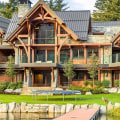When it comes to building a home, one of the fundamental decisions homeowners face is the choice of construction method. Two popular options are timber frame and log construction. Each has its unique aesthetic appeal, structural characteristics, and cost implications. A common question that arises in this context is: "Is timber frame cheaper than log?" This comprehensive guide will explore the cost factors associated with both timber frame and log construction to provide a clear understanding of which option might be more cost-effective.
Material Costs
One of the primary factors influencing the cost of construction is the material cost. Timber frame construction typically uses large wooden beams made from high-quality timber such as oak, pine, or cedar. These beams are precisely cut and joined together using traditional mortise and tenon joinery or modern metal connectors. Log construction, on the other hand, involves the use of whole logs, which can be sourced from a variety of tree species, including pine, spruce, and cedar. While the raw cost of logs can sometimes be lower than that of high-quality timber beams, the total material cost for log construction can be higher due to the sheer volume of wood required.
Labor and Construction
The labor costs associated with timber frame and log construction can vary significantly. Timber frame homes often require skilled craftsmen to cut and assemble the beams, which can be time-consuming and labor-intensive. However, once the frame is erected, the process of enclosing the structure with insulating panels or other materials can be relatively quick and straightforward. Log construction, by contrast, involves the meticulous placement and fitting of each log, which can be a labor-intensive process. Additionally, the notching, scribing, and sealing of logs require specialized skills and tools, potentially driving up labor costs.
Insulation and Energy Efficiency
Another important consideration in the cost comparison between timber frame and log homes is insulation and energy efficiency. Timber frame homes typically incorporate high levels of insulation within the wall and roof systems, leading to excellent energy efficiency and lower heating and cooling costs over time. Log homes, while naturally providing some degree of thermal mass, often require additional insulation measures to achieve comparable energy efficiency. The cost of these insulation upgrades can add to the overall expense of log construction.
Maintenance and Longevity
Maintenance is a crucial factor in the long-term cost of both timber frame and log homes. Timber frame homes, once properly constructed and enclosed, generally require minimal maintenance. The timber is protected from the elements by the exterior cladding and roofing materials, ensuring longevity and durability. Log homes, however, are more exposed to weather conditions and require regular maintenance to prevent issues such as rot, insect infestation, and settling. This ongoing maintenance can add to the long-term cost of owning a log home.
Aesthetic and Design Considerations
Both timber frame and log homes offer distinct aesthetic appeals that can influence cost considerations. Timber frame homes provide a versatile design platform, allowing for a wide range of architectural styles and interior finishes. This flexibility can lead to cost savings by enabling homeowners to choose materials and finishes that fit their budget. Log homes, while offering a unique and rustic charm, often have more rigid design constraints due to the nature of the logs themselves. Customizing a log home to achieve a specific look or layout can be more expensive and complex.
Regional Factors
Regional factors, such as the availability of materials and local labor rates, can also impact the cost comparison between timber frame and log construction. In areas where timber is abundant and skilled timber framers are readily available, timber frame construction may be more cost-effective. Conversely, in regions with a strong tradition of log building and an ample supply of suitable logs, log construction might be more affordable. Homeowners should consider these regional variables when making their decision.
Conclusion
In conclusion, the question of whether timber frame construction is cheaper than log construction does not have a straightforward answer. The cost-effectiveness of each method depends on various factors, including material costs, labor requirements, insulation and energy efficiency, maintenance needs, aesthetic preferences, and regional considerations. While timber frame homes often have higher upfront material and labor costs, their superior energy efficiency and lower maintenance requirements can lead to long-term savings. Log homes, with their unique charm and potential for lower initial material costs, may appeal to those seeking a rustic aesthetic, but they come with higher maintenance demands. Consulting with professionals, such as All County Roofing, can provide valuable insights and help homeowners make an informed decision that aligns with their budget and vision for their home. Ultimately, the choice between timber frame and log construction should be based on a comprehensive evaluation of all these factors to ensure the best value and satisfaction for the homeowner.



